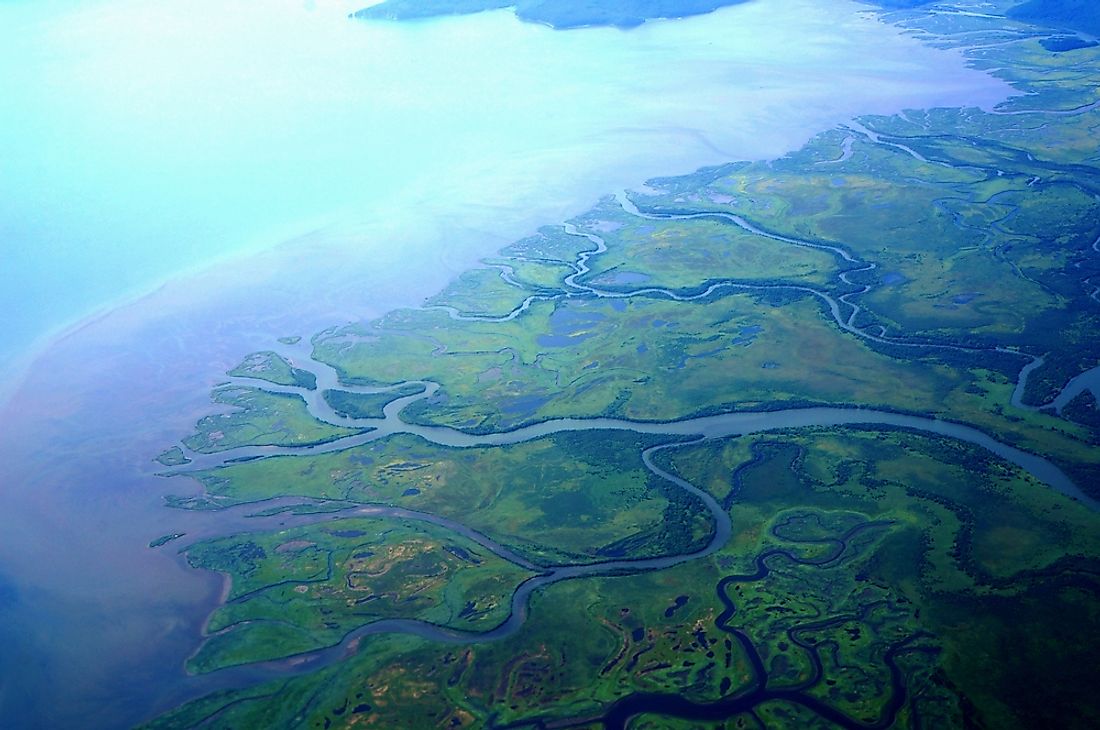How Do Human Activities Threaten Deltas Across The World?

A river delta is a landform that is usually formed at the mouth of a river as it empties into the sea. As the river reaches the sea, it is loaded with sediments which are deposited at its mouth, where its speed is slow or still. As the sediments accumulate and create barriers to the flow of the river, the river branches out into distributaries which finally drain into the sea. Waves, wind, and tidal forces act to erode the sediments of the delta, helping maintain a balance between the deposition of sediments by the river and erosion by these forces.
Why Are Deltas Important?
Deltas throughout the world, such as the Amazon in Brazil, the Nile in Egypt, and the Ganga-Brahmaputra Delta in the Indian subcontinent, are beneficial to humans as they often have fertile soils that support agricultural practices. The close proximity to the sea and the opportunity of navigating inland encourages trade and industry in deltaic regions. Fishing is also a flourishing activity in such areas. Thus, river deltas are some of the most densely populated areas of the world.
Threats to Deltas
Although deltas have shaped human civilization, human activity is now shaping and threatening delta ecosystems. Despite the fact that humans rely on deltas to a great extent for their livelihoods, human activity has increased the degradation of deltas across the world. Some of the biggest threats to deltas are described below.
1. Construction of Dams
Construction of dams to yield hydroelectric power, reduce flooding, or divert river water to drier areas is one of the biggest threats to deltas. Such landscapes are dependent on the sediments deposited by rivers, and if these deposits decrease and are unable to balance the forces of erosion, then the deltas will gradually recede. The construction of dams is contributing to this problem. Dams are generally constructed at the upper or middle parts of a river and divert water to reservoirs. As a result, parts of the river downstream have a lower volume of water and sediments. Thus, the delta at the mouth of the river receives a lower volume of sediments than it did prior to construction of the dam. The reduced deposition might not be sufficient to counter the forces of erosion, and eventually the delta will lose sediments and retreat.
2. Mining Activities
Sand mining can be destructive to river deltas. However, the potentially disastrous effects of such mining is not popularly known. According to a report by the World Wildlife Fund for Nature (WWF), every year around 50 billion tons of gravel and sand are mined to supply the rapidly growing construction and land reclamation industries around the world. Unsustainable sand mining near river deltas negatively alters the shape and size of such regions. As more and more sediments are removed from of a delta, the delta starts sinking. This effect on the delta ultimately leads to a loss of agricultural land and property, as well as the failure of dikes, bridges, and roads.
3. Channeling a River Downstream
When a river's water is diverted through various channels into several locations inland, it can shrink the size of the delta at the mouth of the river. For example, artificial channels are often dug along the course of a river to lead some of its waters into interior areas where water is scarce. The effects of channeling are similar to that of dam construction, as a lower volume of water with a lower sediment concentration reaches the sea. The lower deposition of sediments thus leads to the degradation of deltas.
4. Massive Alteration of the Landscape of a Delta
When the human population in a delta region becomes extremely high and unsustainable living standards exist, the delta becomes vulnerable to degradation. Over-harvesting of river water and groundwater, construction of buildings without paying heed to environmental norms, and high levels of pollution can all adversely affect the soil and water of a delta. The overall quality of water and soil in these deltas becomes poor. Other life forms cease to survive in such degraded habitats and it also becomes unfit for human living.
5. Climate-Change Induced Rising Sea-Levels
The world is currently experiencing global climate change. Rising temperatures are melting polar ice caps and increasing sea-levels. Deltas in lowland areas that are in close proximity to the sea are highly susceptible to flooding due to rising sea-levels. Such floods can wash away large volumes of sediments that form the delta.











